By Dianna Moore
Grays Harbor Audubon Society
The European Starling is the bird everyone loves to hate.
A real pest bird but with a beautiful iridescence which goes unappreciated by we humans for the most part. If you have ever spent any time watching one in a birdbath in the sun it can be quite rewarding. They are also pretty good at cleaning pests out of your lawn, with large appetites for insects, so if you have a lawn you probably have starlings visiting. They have a wonderful repertoire of vocalizations that please the ears, whether it be one of a whole flock of birds. This photo by Gregg Thompson shows a starling just outside a nest hole in the tree.
General Description: Starlings can be found anywhere in the world where there is open space, avoiding only large spaces of desert and dense forest. They were first introduced to North America by Shakespeare enthusiasts in the 19th century and have now spread across the continent and are one of the continents most numerous songbirds. The breeding birds are glossy, dark birds with spots and purple-green iridescence, a short tail, and a thin, straight yellow bill. Non-breeding birds are dark with light spots and a black beak. Juveniles are a drab grayish-brown.
Habitat: Starlings live quite comfortably with human-altered settings and disturbed areas. They can be found in practically all habitats, with the exception of large tracts of undisturbed forests and undeveloped alpine areas. Their main requirements are open grassy areas in which to forage, a water source, and trees or buildings that contain suitable cavities or niches for nesting.
Behavior: European Starlings form large flocks in the fall and winter and these flocks often contain an assortment of other foraging birds such as Red-winged Blackbirds, Brown-headed Cowbirds, American Robins, Crows and Rock Pigeons. They are extremely aggressive birds and will defend their territories as well as harass other species to take over nesting cavities. They also work together to mob predatory birds such as hawks, eagles, owls and falcons. They use their intelligence to get what they want and need. They are also very competent mimics.
Diet: Starlings eat a diverse, omnivorous diet of invertebrates, berries and other fruit, grains, and seeds. Actually, they will eat just about anything, from spiders to livestock feed to garbage. Their preference is for insects and invertebrates.
Nesting: Although starlings are usually monogamous, they can also be polygamous. Males choose territories early in the season and begin building a nest to attract a female. European Starlings are cavity nesters, and nests are generally located in natural hollows, old woodpecker holes, birdhouses, or building eaves and crevices. Although the male begins the nest, the female often removes anything he put in the cavity to arrange it to her suitability. It is a loose pile of twigs, weeds, grass, feathers, leaves, and other material, with a depression in the middle. Both incubate four to six eggs for about 12 days. The female may even lay her eggs in another starlings nest, then go on to raise another brood. Both adults help brood the young and bring food to the nest. The young leave the nest after about three weeks and can forage on their own, but the adults may continue to feed them for another few days. If this is the first brood, the female typically starts laying a second brood shortly after the first one fledges. The male may provide support for up to 12 days after the young leave the nest, and the young often join other newly fledged young on communal roosts.
Migration: European Starlings appear to be partially migratory but patterns vary regionally and individually. Many birds move into valleys and urban areas during the winter.
Conservation Status: It is hard to imagine now, but European Starlings were purposefully introduced into the United States from Europe. The effort failed twice before a successful introduction of about 60 birds was made in New York City’s Central Park in 1890. Those birds reproduced and spread quickly across developed and other human-altered habitats. European Starlings were first recorded in Washington in 1943, only 53 years later. The first confirmed breeding was in 1951, and by then starlings had crossed into western Washington. The first record in the Puget Sound region was in 1949, and the first western Washington breeding was in 1955. By 1977, only 34 years after they first appeared in Washington, European Starlings were abundant throughout the state. The Breeding Bird Survey recorded only a slight, not statistically significant, increase in Washington between 1966 and 2002. However even if the population increase is leveling off, current numbers are high enough that European Starlings are considered pests. European Starlings have had a strong negative impact on many cavity-nesting birds, Western Bluebirds, Lewis’ Woodpeckers, and Purple Martins among them. A number of control methods have been proposed, but as yet no successful, cost-effective, sustainable methods have been discovered.
When and Where to Find on the Harbor: European Starlings are abundant year round in most lower-elevation habitats throughout Washington, especially in proximity to human development.



